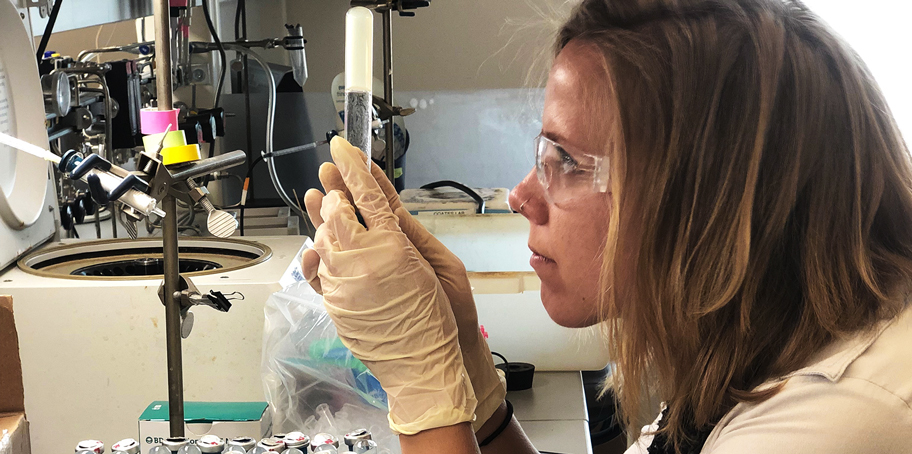January 8, 2019 — John Coates’ laboratory at the University of California, Berkeley, hums with activity. Negative 80-degree freezers whirr, liquid nitrogen bubbles, grad students meticulously measure and mix complicated concoctions. But all of this is nothing compared with the commotion going on at a microscopic level.
The Coates lab is growing many different kinds of bacteria, multiplying in petri dishes at mind-boggling rates. But these bacteria aren’t out to harm people or animals. In fact, quite the opposite — they’re hard at work breaking down a dangerous chemical that pollutes waterways across the United States.
The chemical, called perchlorate, comes from rocket fuel, munitions and fireworks. It’s dangerous to humans because it can impair thyroid function. It can also affect the thyroid in freshwater animals like fish and amphibians, even altering gonad development in some animals. But certain bacteria, including several species of Dechloromonasand Azospira, have evolved to use perchlorate to make energy-storing molecules. In the process, they turn it into harmless chloride and oxygen.
Coates is just one of many scientists across the globe who are working to harness the ability of various bacteria to remove harmful pollutants from water. This is no easy task. There are thousands of different pollutants — industrial chemicals, pesticides, herbicides, fertilizers, metals and more — and no one microbe can break down all. Also, because bacteria need special conditions to survive, it can be difficult to incorporate them into water treatment systems.
In spite of these challenges, Coates sees a future full of possibility. “It’s really just a question of sitting down and spinning your brain around all the cool, novel aspects of these organisms and then asking where can we apply this?” he says.
Perchlorate Decon
Perchlorate is mostly used in rocket fuels and munitions. Improper storage or disposal of rockets or debris may contaminate the environment. Through leaks or explosions, perchlorate can also pollute waterways near manufacturing plants. It’s water soluble and chemically stable, so it can persist in ground and surface water for decades.
And that’s bad news for people whose drinking water comes from contaminated sources, especially pregnant women and children. Perchlorate has been shown to impair thyroid function; proper thyroid function is essential for normal brain development during the prenatal period and during childhood.
When Coates submitted his first academic paper on perchlorate-degrading bacteria in 1998 (it was published in 1999), there were only a few bacterial species known to be capable of performing this feat. Coates wanted to see if there were more.
“It turns out that the microorganisms that use perchlorate are essentially ubiquitous — they’re not difficult to find. And you can culture them fairly readily. To remediate perchlorate, you just needed to create specific conditions,” he says.
The way to do this is to use something called a bioreactor — a home for bacteria that provides all the nutrients and minerals they need to thrive. It’s similar to a fermenting tank for beer, except instead of yeast converting sugars into alcohol and carbon dioxide, perchlorate-destroying bacteria turn dangerous perchlorate into harmless chloride and oxygen. Contaminated ground or surface water gets pumped into the bioreactors, which are full of these bacteria. Once the bacteria have broken down the perchlorate, the water is filtered and sterilized to remove bacteria. The decontaminated water can then be sent to consumers or pumped back into the ground.
Thanks to discoveries made by Coates and a legion of other scientists, perchlorate-decontaminating bioreactors have been applied in the real world with great success. Large-scale perchlorate bioreactors are now at work cleaning contaminated water at several sites in California, Kansas, Texas and Utah. These bioreactors are astonishingly efficient: The bioreactor-based groundwater treatment plant in Rialto, California, for example, is capable of decontaminating 2,000 gallons (over 7,500 liters) of perchlorate-polluted water per minute — that’s more than a billion gallons (over 3.7 billion liters) a year. In fact, Coates says that the bacterial removal of perchlorate represents one of the largest-scale bioremediation projects in the world.
Converting Uranium
Implementing bioreactor technologies isn’t always so straightforward, even when the bioreactor performs well in the lab. A bioreactor designed by Bruce Rittmann, the director of the Swette Center for Environmental Biotechnology at Arizona State University’s Biodesign Institute, was initially used to remove water contaminants like perchlorate and trichloroethene, but can also be used to remove uranium and other metals from water. This kind of contamination can occur around uranium mines and mills, especially older abandoned ones. In people, drinking water contaminated with uranium can cause kidney damage; uranium is also toxic to fish, decreasing their reproductive success.
The bacteria in the bioreactor can’t destroy the uranium, but they can convert it to a form that separates from water. Once the uranium comes out of the solution, it’s much easier to remove —think about the difference between taking a sugar cube out of a glass of water and trying to remove the sugar once it’s dissolved. In tests, Rittmann’s bioreactor removed about 95 percent of the uranium from a contaminated water supply.
“In these cases, the materials that we produce — the solids these microbes remove from the water — are really valuable. We’re working on the development of this technology not only to remove pollutants but to generate high value.” –Bruce Rittmann
Rittmann says it would be relatively straightforward to construct a bioreactor system in currently operational mines that already have some sort of water treatment system in place. However, cleaning up abandoned mines would be more difficult, since they have no such infrastructure. There are about 4,000 abandoned uranium mines in America’s western states.
This technology, Rittmann says, can be applied not just to water contaminated by uranium mines but also to wastewater from precious metal mines, including silver, gold and palladium. “In these cases, the materials that we produce — the solids these microbes remove from the water — are really valuable. We’re working on the development of this technology not only to remove pollutants but to generate high value. It’s a good deal,” he says.
Beyond the Bioreactor
What if we want to break down pollutants in places where building bioreactors isn’t feasible, like in runoff from agricultural fields contaminated with pesticides? Colin Scott, head of the Biocatalysis & SynBio Team at Australia’s Commonwealth Scientific and Industrial Research Organization (CSIRO), may have an answer.
Bacteria make enzymes, and it’s these enzymes that do the dirty work of actually breaking down pollutants. So, Scott and his team are experimenting with bacterial enzymes to decontaminate water systems polluted with pesticides and herbicides. Enzymes aren’t alive, so they don’t need nutrients, which means they can be used in places that bacteria won’t survive. They can’t reproduce or adapt, so won’t multiply and disturb delicate ecosystems.
“Enzymes themselves are terrific because they’re really specific for the thing that you want them to do, so they don’t have any other effects. And they’re also biodegradable, so they don’t persist in the environment,” says Scott.
Such enzymes are not yet used on a large scale, but they’ve been successful in field tests. For example, a bacterial enzyme called OP-A is capable of breaking down organophosphate insecticides, which have been linked to deficits in attention, coordination and memory, especially in agricultural workers. In field trials, the OP-A enzyme reduced levels of the controversial pesticide chlorpyrifos — linked to impaired brain development in children — in contaminated field runoff by 99 percent in just eight hours. (Since these tests, the researchers say they have developed an improved version of OP-A, known as A900.)
For many pollutants — including many pesticides — there’s currently a whole lot of nothing being done.
The specificity of enzymes is both their brilliance and their downfall. On one hand, high specificity means that enzymes aren’t likely to produce unwanted side effects, like harming plants or animals. On the other hand, there are thousands of different pollutants, which means we’ll need a lot of different enzymes.
After an appropriate enzyme has been identified, scientists have to figure out how to cost-effectively mass produce it. Since enzymes usually biodegrade quickly, scientists have to make sure the enzyme stays intact long enough to do its job. They also have to run safety studies to make sure that whatever components the enzymes break the pollutant down into aren’t also toxic.
A Long Way to Go
There’s still a lot of work to be done. At the science level, we need to identify and characterize bacteria that can break down specific pollutants. Although bacteria for degrading or removing contaminants like perchlorate, uranium and certain pesticides are well understood, as-yet undiscovered bacteria may be important in dealing with emerging water pollutants such as PFAS, which can cause immune system dysfunction and cancer, as well as pharmaceuticals, the effects of which are not yet fully understood.
Other hurdles are policy based. It’s often not a question of whether to use bioremediation or alternative techniques, but whether to do anything at all. Many contaminants — including several pesticides, cyanotoxins and solvents — are monitored by the EPA, but not regulated. Without set limits for acceptable amounts of these chemicals in drinking water, there’s no incentive for anyone to spend money to get rid of them. Even though bioremediation may be cheaper than the alternatives, in the short term, it’s still more expensive than doing nothing. And for many pollutants — including many pesticides — there’s currently a whole lot of nothing being done.
But with the continued work of scientists and stricter water quality standards, bacteria could be a public health game-changer.
“These bugs are amazing,” says Coates. “What limits us is our imagination rather than the organisms’ abilities.”
![]()
Editor’s note: Hannah Thomasy wrote this story as a participant in the Ensia Mentor Program. The mentor for the project was Brian Bienkowski.
Related Posts
Ensia shares solutions-focused stories free of charge through our online magazine and partner media. That means audiences around the world have ready access to stories that can — and do — help them shape a better future. If you value our work, please show your support today.
Yes, I'll support Ensia!




